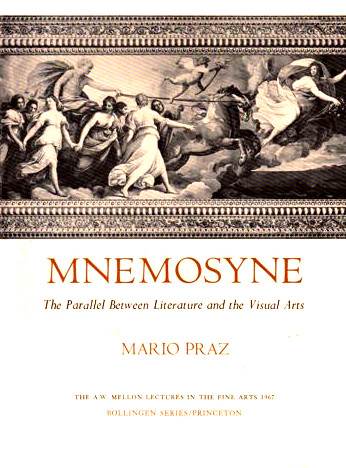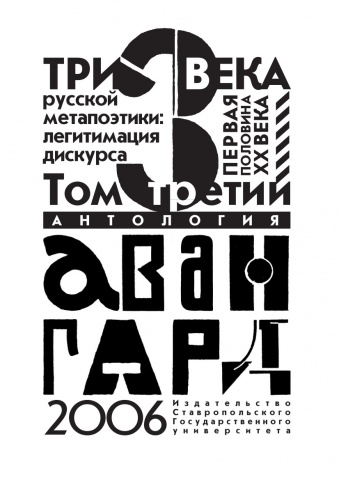Mario Praz: Mnemosyne: The Parallel Between Literature and the Visual Arts (1970–) [English, Spanish]
Filed under book | Tags: · art, art history, art theory, history of literature, literary theory, literature, memory, poetry

In his search for the common link between literature and the visual arts, Professor Praz draws upon the abundant evidence of long mutual understanding and correspondence between the sister arts. Although parallels of theme and inspiration are plentiful, he is not primarily concerned with these. Rather, he examines the close relationship or air de famille between the expression of the arts in any given epoch.
Each epoch has “its peculiar handwriting or handwritings, which, if one could interpret them, would reveal a character, even a physical appearance.” Although handwriting is taught and some of its characteristics thus belong to the general style of the period, the personality of the writer does not fail to pierce through. Something of the same sort, the author proposes, occurs in art. The kinship of literature and painting rests on this circumstance: a work of art, whether visual or literary, must use the distinctive “handwriting” of its particular age, even as its originality pierces through this handwriting.
The likeness between the arts within various periods of history can ultimately be traced, then, to structural similarities — similarities that arise out of the characteristic way in which the people of a certain epoch see and memorize facts aesthetically. Mnemosyne, at once the goddess of memory and the mother of the muses, therefore presides over this view of the arts. In illustrating her influence, Professor Praz ranges widely through Western sources, both literary and pictorial. (from the dust jacket)
The A.W. Mellon Lectures in the Fine Arts, 1967
Publisher Princeton University Press, 1970
Bollingen Series XXXV, 16
ISBN 9780691098579
261 pages
Review (E.H. Gombrich, 1972)
Review (D.C., Spenser Newsletter, page 3, 1971)
Review (in Japanese)
Publisher (EN)
Mnemosyne: The Parallel between Literature and the Visual Arts (English, 1970)
Mnemosyne: El paralelismo entre la literatura y las artes visuales (Spanish, trans. Ricardo Pochtar, 1979, no OCR, via Daniel Ferreira)
K.E. Shtayn (ed.), Three Centuries of Russian Metapoetics, Vol. 3: Avant-Garde: Cubo-Futurism, Ego-Futurism, Centrifuge, Rayonism, Imaginism, Proletkult, LEF, VAPP, Constructivism, Oberiu (2006) [Russian]
Filed under book | Tags: · 1910s, 1920s, 1930s, art history, avant-garde, constructivism, cubo-futurism, ego-futurism, formalism, futurism, literary theory, literature, poetry, proletkult, russia, visual poetry

An encyclopedic collection of Russian literary avant-garde writing of the first half of the 20th century.
Tri veka russkoy metapoetiki: Legitimatsiya diskursa, Tom 3: Pervaya polovina XX veka. Avangard: Kubofuturizm. Egofuturizm. Tsentrifuga. Luchizm. Imazhinizm. Proletkul’t. Lef. VAPP. Konstruktivizm. OBERIU
Publisher Izdatelstvo Stavropolskogo gosudarstvennogo universiteta, Stavropol, 2006
ISBN 5886485120
830 pages
Russian avant-garde bibliography at Monoskop wiki
PDF
See also Russkaya metapoetika. Uchebnyy slovar, 2006
Download another 3 volumes
Josef Hiršal, Bohumila Grögerová (eds.): Slovo, písmo, akce, hlas: K estetice kultury technického věku (1967) [Czech]
Filed under book | Tags: · aesthetics, art, art theory, avant-garde, chance, computer art, concrete poetry, experimental art, fluxus, happening, kinetic art, lettrism, literary theory, manifesto, music theory, poetry, technology, visual poetry

A unique anthology of essays, manifestos and artistic programs from the period 1950-1965 by Jasia Reichardt, George Brecht, George Maciunas, Ben Vautier, Eugen Gomringer, Décio Pignatari, Max Bense, Umberto Eco, and others.
“Tento sborník teoretických studií, esejů, článků a uměleckých manifestů napsaných v prvních patnácti letech druhé poloviny dvacátého století, chce být v prvé řade informací. Informací o estetice toho, co bývá globálně nazýváno experimentálním uměním, vznikajícím v technické civilizaci a realizujícím rozličné tendence a programy v různých částech světa. Chce osvětlit tento pojem a poukázat na rozdílnost jeho aplikací i výkladů. Navíc pak chce poskytnout v českém překladu přímo pramenné materiály o nových druzích poezie (o poezii umělé, konkrétní, auditivní, verbofonické, grafické), o umění lettristickém, permutacionálním, totálním, o splývaní dosud samostatných uměleckých disciplín a žánrů i o krystalizaci a výskytu nových, reprezentovaných především akcemi (happening aj.).
Ve sborníku je zařazeno vedle statí, studií a manifestů uměleckých skupin, teoretiků i samotných umělců i několik přehledů historických a vývojových, ukazujících souvislosti současného umění s etapami předchozími a podávajících další důkazy o jeho univerzalitě i diferenciaci. Materiály sborníku netvoří ani v náznaku kompaktní celek. Jsou spíše jednotlivými, někdy dokonce přímo si odporujícími hlasy vzrušeného rozhovoru, vytvářejí konglomerát různých tendencí, názorů a reakcí na skutečnost a stav civilizace druhé poloviny našeho století v rozdílných společenských podmínkách. Záměřem pořadatelů bylo přiblížit je našim zasvěcenějším i laickým čtenářům a poskytnout tak hlubší předpoklady k vnímání současných uměleckých artefaktů i k pochopení jejich metodologie.
Shrnutím nejvýraznějších, mnohdy však i nejproblematičtějších současných estetických tendencí představuje tento sborník materiál, který — právě snad pro svou názorovou diferenciaci, rozpornost a nesmiřitelnost — nemá dosud ve světě obdoby. Bylo by si proto jen přát, aby se názorům a informacím v něm obsaženým dostalo žádoucího doplnění ve zpřístupnění korespondujících konkrétních uměleckých výtvorů jak světové, tak i naší skromnější provecience, resp. v pokračujícím zpřístupňování, protože mnohé již u nás známe jsou. Padly by tak poslední falešné mýty a představy — a to jak ze strany snobů, tak diletantů — a byla by i v této oblasti dokořán otevřena cesta k přirozenému a nevyhnutelnému vývojovému výběru.” (from the Introduction)
With an Afterword by Jiří Levý
Publisher Československý spisovatel, Prague, 1967
Volume 1 of Monoskop Unlimited Edition series
256 pages
PDF (40 MB, no OCR)
Comment (0)
